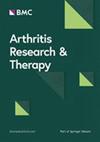高强度运动改善类风湿关节炎患者多维度疲劳和健康相关生活质量:一项随机对照研究
IF 4.6
2区 医学
Q1 Medicine
引用次数: 0
摘要
长时间的疲劳在类风湿关节炎(RA)患者中很普遍,体力活动被推荐作为管理疲劳的辅助治疗选择。然而,体力活动的类型和剂量尚未确定。这项随机对照多中心研究的目的是评估高强度间歇训练(HIIT)和力量锻炼对类风湿关节炎患者疲劳、睡眠、情绪、疼痛和健康相关生活质量的影响。总共有87名被诊断为类风湿性关节炎的参与者,平均年龄48岁(SD 9.66),其中84%为女性,被随机分配到干预组(IG) (n = 43)进行12周的监督HIIT和力量锻炼,或对照组(n = 44)进行一般体育活动建议咨询。在基线、3个月、6个月和12个月时评估自我给药措施;多维疲劳量表(MFI - 20)、匹兹堡睡眠质量指数(PSQI)、医院焦虑抑郁量表(HADS)、疼痛量表(VAS)、健康相关生活质量量表(VAS-global)。用DAS28-ESR评估疾病活动性。统计分析采用协方差分析(ANCOVA)和混合模型重复测量分析。在3个月时,MFI-20亚量表的变化有显著的平均组差异,一般疲劳-4.0 (95%CI -5.57至-2.39),身体疲劳-4.9 (95%CI -6.43至-3.36),活动减少-2.5 (95%CI -3.84至-1.20),动机减少-1.8 (95%CI -2.97至-0.62),有利于IG。此外,VAS-global的平均组差异为-12.8 (95%CI为-21.3至-4.3),这有利于IG。在6个月的随访中,总体疲劳-2.4 (95%CI -3.85至-0.92),身体疲劳-3.7 (95%CI -5.25至-2.10),活动减少-2.0 (95%CI -3.53至-0.39),动机减少-1.6 (95%CI -2.93至-0.16)和vas -全球-9.2 (95%CI -17.47至-0.94)的显著平均组差异持续存在。随访12个月时,两组在体力疲劳、抑郁情绪、疼痛和VAS-global指标上的平均差异均有统计学意义(p值< 0.05),仍有利于IG组。高强度运动干预对类风湿性关节炎患者的多维疲劳和健康相关生活质量有有益影响。在12个月的随访期间,对疲劳和健康相关生活质量的影响持续存在,表明长期影响。该试验在“瑞典研究与发展”(FoU in Sweden)前瞻性注册(注册号:275642),并在trial gov (NCT 05768165)回顾性注册。本文章由计算机程序翻译,如有差异,请以英文原文为准。
High-intensity exercise improves multidimensional fatigue and health-related quality of life in rheumatoid arthritis: a randomized controlled study
Prolonged fatigue is prevalent in people with rheumatoid arthritis (RA), and physical activity is recommended as an adjunct treatment option to managing fatigue. However, the type and dose of physical activity is not established. The purpose of this randomized controlled multicenter study was to evaluate the effect of high-intensity interval training (HIIT) and strength exercise on fatigue, sleep, mood, pain and health-related quality of life in people with RA. In total, 87 participants diagnosed with RA, mean age 48 (SD 9.66) Years and 84% females, were randomly assigned to an intervention group (IG) (n = 43) performing supervised HIIT and strength exercise for 12 weeks, or a control group (n = 44) with counseling of the general physical activity recommendations. Self-administered measures were assessed at baseline, 3 months, 6 months and 12 months; the Multidimensional Fatigue Inventory (MFI 20), the Pittsburgh Sleep Quality Index (PSQI), the Hospital Anxiety and Depression Scale (HADS), pain (VAS), health-related quality of life (VAS-global). Disease activity was assessed with the DAS28-ESR. Statistical analyses were performed using Analysis of Covariance (ANCOVA), and mixed model repeated measure analysis. At 3 months, a significant mean group difference in change was found on MFI-20 subscales General fatigue -4.0 (95%CI -5.57 to -2.39), Physical fatigue -4.9 (95%CI -6.43 to -3.36), Reduced activity -2.5 (95%CI -3.84 to -1.20), and Reduced motivation -1.8 (95%CI -2.97 to -0.62), favoring the IG. Additionally, a significant mean group difference in change was seen on VAS-global -12.8 (95%CI -21.3 to -4.3), in favor of the IG. At 6 months follow-up, the significant mean group difference on General fatigue -2.4 (95%CI -3.85 to -0.92), Physical fatigue -3.7 (95%CI -5.25 to -2.10), Reduced activity -2.0 (95%CI -3.53 to -0.39), Reduced motivation -1.6 (95%CI -2.93 to -0.16) and VAS-global -9.2 (95%CI -17.47 to -0.94) persisted. At 12 months follow-up a significant mean group difference was seen on Physical fatigue, depression mood, pain and VAS-global (p-value < 0.05), still in favor of the IG. The high-intensity exercise intervention had a beneficial effect on multidimensional fatigue, and health-related quality of life in people with RA. The effect on fatigue and health-related quality of life persisted during the 12 months-follow up period indicating long-term effects. The trial was registered prospectively on “FoU in Sweden” (Research and Development in Sweden), (registration number: 275642), and retrospectively on Trial Gov. (NCT 05768165).
求助全文
通过发布文献求助,成功后即可免费获取论文全文。
去求助
来源期刊

Arthritis Research & Therapy
RHEUMATOLOGY-
CiteScore
8.60
自引率
2.00%
发文量
261
审稿时长
14 weeks
期刊介绍:
Established in 1999, Arthritis Research and Therapy is an international, open access, peer-reviewed journal, publishing original articles in the area of musculoskeletal research and therapy as well as, reviews, commentaries and reports. A major focus of the journal is on the immunologic processes leading to inflammation, damage and repair as they relate to autoimmune rheumatic and musculoskeletal conditions, and which inform the translation of this knowledge into advances in clinical care. Original basic, translational and clinical research is considered for publication along with results of early and late phase therapeutic trials, especially as they pertain to the underpinning science that informs clinical observations in interventional studies.
 求助内容:
求助内容: 应助结果提醒方式:
应助结果提醒方式:


